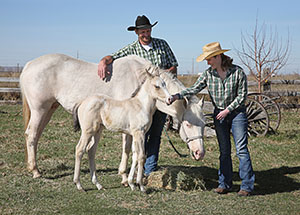Applying the "Whole Farm" Concept to Apartment Buildings
 |
|
Riding white horses and wearing Stetson hats—practicing IPM helps people breathe more easily. Photo: iStock |
That cockroach creeping across your neighbor’s apartment floor is certainly spewing forth tiny asthma-triggering allergens—a vicious band of Wild West gunmen raiding the whole farm of human dwellings. Indeed, a 2005 National Institutes of Health study found that cockroach allergens have the greatest impact on childhood asthma in urban settings.1
“Think of the building as an ecosystem,” says Jody Gangloff-Kaufmann with the New York State IPM Program. “Apartments, high rises, and basically any built structure that interfaces with the environment can be considered an ecosystem that offers entry points for pests.”
The German cockroach not only annoys, says Changlu Wang of Rutgers University, it tops the public housing enemy list not only because of its prevalence, but because of health risks associated with asthma and improper use of insecticide sprays. In New York City alone, 16 percent of households have cockroach infestations.2
If an apartment building is the whole farm, then the German cockroaches would be the cattle rustlers. Residents wielding cans of insecticide would be the misguided vigilantes. Wang and his partner Amanda Eiden of Rutgers would be riding white horses and wearing Stetson hats, trying to help people breathe more easily and reduce unnecessary exposure to pesticides.
“You risk your skin catching killers and the juries turn them loose so they can come back and shoot at you again,” said the character Martin in the 1952 movie High Noon, a quote related to our story only metaphorically.
But we can see this metaphor play out as risky chemical sprays are used, killing a small portion of the cockroach population, only to have those hiding in the walls cause the numbers to rebound. A whole-farm approach requires the conditions that support the cockroach population (water, food, and shelter) to be eliminated, and involves all the players—residents, building managers, and pest control technicians—joining forces against the raiders, and using more effective IPM tools, such as vacuums and baits.
A recent survey shows 71 percent of residents applied insecticide sprays for cockroach control, even though IPM strategies are safer and more effective.
“Spraying cockroaches is like farming them,” said Susannah Reese of the Stop Pests in Housing Program. “Sprays take out some, but the population keeps growing.”
In 2017, the Northeastern IPM Center awarded Wang and Eiden $50,000 to study people’s reactions to cockroach infestations. They want to understand when people start to reach for the can of all-purpose roach spray—and hopefully cut them off at the pass.
To do so, they are developing a threshold measure they call “aesthetic injury level,” or AIL.
The aim is to monitor AIL and cockroach populations and better understand the association between them.
In Wild West terms, it’s a plan to clean this town up, make it fit for families with kids to live in. And keep the raiders off the farm in the first place.
— Chris Gonzales and Susannah Reese
References
1 – https://www.sciencedaily.com/releases/2005/03/050321085558.htm
2 – http://www.realtor.com/news/trends/americas-worst-pest-infested-cities
The Northeastern IPM Center promotes integrated pest management for reducing risks to human health and the environment. If republishing our news, please acknowledge the source (“From Northeast IPM Insights”) along with a link to our website.
